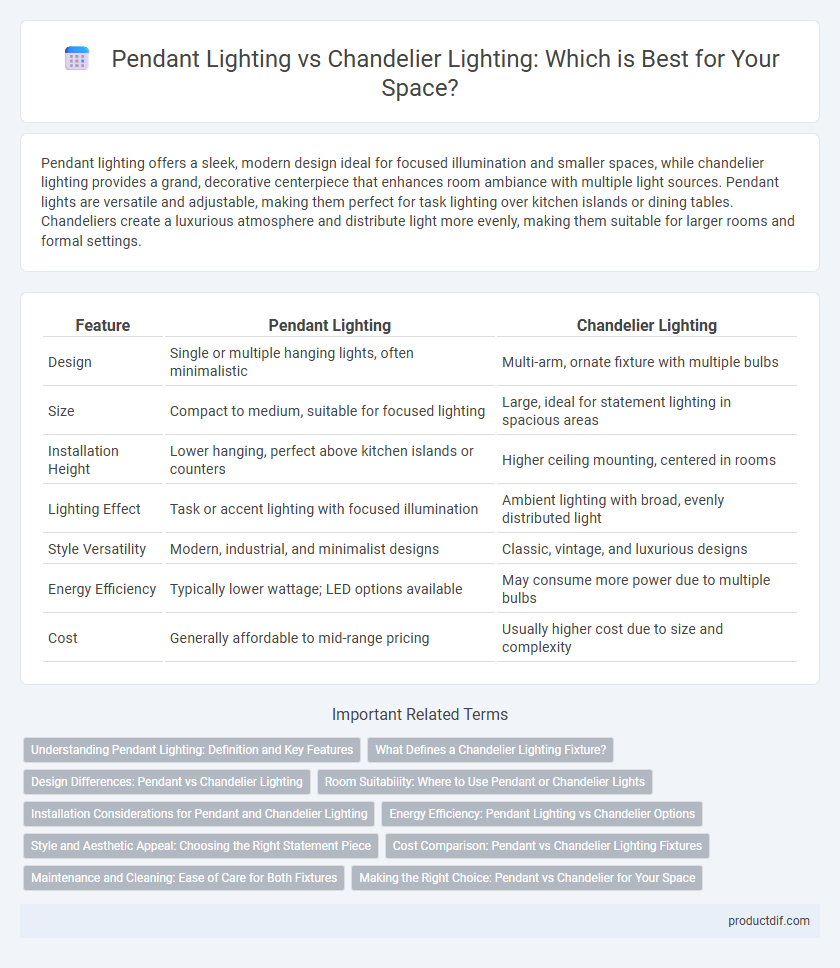Pendant lighting offers a sleek, modern design ideal for focused illumination and smaller spaces, while chandelier lighting provides a grand, decorative centerpiece that enhances room ambiance with multiple light sources. Pendant lights are versatile and adjustable, making them perfect for task lighting over kitchen islands or dining tables. Chandeliers create a luxurious atmosphere and distribute light more evenly, making them suitable for larger rooms and formal settings.
Table of Comparison
| Feature | Pendant Lighting | Chandelier Lighting |
|---|---|---|
| Design | Single or multiple hanging lights, often minimalistic | Multi-arm, ornate fixture with multiple bulbs |
| Size | Compact to medium, suitable for focused lighting | Large, ideal for statement lighting in spacious areas |
| Installation Height | Lower hanging, perfect above kitchen islands or counters | Higher ceiling mounting, centered in rooms |
| Lighting Effect | Task or accent lighting with focused illumination | Ambient lighting with broad, evenly distributed light |
| Style Versatility | Modern, industrial, and minimalist designs | Classic, vintage, and luxurious designs |
| Energy Efficiency | Typically lower wattage; LED options available | May consume more power due to multiple bulbs |
| Cost | Generally affordable to mid-range pricing | Usually higher cost due to size and complexity |
Understanding Pendant Lighting: Definition and Key Features
Pendant lighting consists of a single light fixture suspended from the ceiling by a cord, chain, or metal rod, offering focused illumination that enhances task areas or accentuates design elements. Key features include adjustable height, versatility in style from modern to industrial, and energy-efficient options such as LED bulbs. Pendant lights are ideal for kitchens, dining areas, or entryways where targeted lighting and aesthetic appeal are essential.
What Defines a Chandelier Lighting Fixture?
A chandelier lighting fixture is defined by its multi-armed design, typically featuring several light sources branching out from a central frame, often adorned with decorative elements such as crystals or metalwork. Unlike pendant lighting, chandeliers are usually larger and designed to serve as a focal point in a room, providing both ambient illumination and aesthetic appeal. These fixtures are commonly installed in dining rooms, foyers, or grand living spaces, where their intricate structures enhance the overall interior design.
Design Differences: Pendant vs Chandelier Lighting
Pendant lighting features singular or grouped fixtures that hang from a ceiling, creating focused illumination and a minimalist aesthetic suitable for contemporary spaces. Chandeliers typically showcase multiple arms or tiers adorned with decorative accents, offering a more elaborate, opulent design ideal for grand or traditional interiors. The structural complexity and size differentiation define their distinct visual impact, with pendants emphasizing streamlined functionality and chandeliers embodying ornate elegance.
Room Suitability: Where to Use Pendant or Chandelier Lights
Pendant lighting is ideal for task-specific areas such as kitchen islands, dining tables, or entryways where focused illumination enhances functionality and style. Chandeliers suit larger, open spaces like living rooms, formal dining rooms, or grand foyers, providing a dramatic centerpiece and ambient lighting. Selecting between pendant and chandelier lighting depends on the ceiling height, room size, and desired lighting effect for optimal aesthetic and practical impact.
Installation Considerations for Pendant and Chandelier Lighting
Pendant lighting requires straightforward installation with a single connection point and is ideal for focused illumination above kitchen islands or dining tables. Chandelier lighting involves more complex installation, including multiple wiring connections and ceiling reinforcement to support its typically heavier weight and larger size. Both fixtures demand careful attention to ceiling height and electrical capacity to ensure safe and effective operation.
Energy Efficiency: Pendant Lighting vs Chandelier Options
Pendant lighting typically consumes less energy than chandeliers due to its smaller size and fewer light sources, making it a more energy-efficient choice for modern homes. LED pendant fixtures further enhance energy savings by using advanced technology that delivers bright illumination with minimal electricity. In contrast, chandeliers often require multiple bulbs, increasing overall energy consumption despite their aesthetic appeal.
Style and Aesthetic Appeal: Choosing the Right Statement Piece
Pendant lighting offers a sleek, modern aesthetic with single or multiple light sources that create focused illumination, ideal for minimalist and contemporary interiors. Chandeliers provide a grand, ornate statement with intricate designs and multiple arms, enhancing traditional or luxurious spaces with a dramatic visual impact. Selecting between pendant and chandelier lighting depends on the desired ambiance, room size, and the statement piece's role in the overall interior design scheme.
Cost Comparison: Pendant vs Chandelier Lighting Fixtures
Pendant lighting fixtures generally cost less than chandeliers due to simpler designs and smaller sizes, with average prices ranging from $50 to $300 per unit. Chandeliers, often featuring intricate details and multiple light sources, typically start at $200 and can exceed $2,000 depending on materials and craftsmanship. Installation costs also tend to be higher for chandeliers because of their weight and electrical complexity compared to pendant lights.
Maintenance and Cleaning: Ease of Care for Both Fixtures
Pendant lighting typically requires less maintenance and easier cleaning due to its simpler design and fewer components, allowing for quick dusting and wiping. Chandelier lighting often demands more care with frequent dusting of multiple arms, crystals, or bulbs and occasional deep cleaning to maintain its brilliance. Choosing between these fixtures depends on the desired aesthetic balanced with the willingness to invest time in upkeep.
Making the Right Choice: Pendant vs Chandelier for Your Space
Pendant lighting offers focused illumination and a modern aesthetic, ideal for task areas like kitchen islands or reading nooks. Chandeliers provide a grand, ambient glow that enhances formal dining rooms or entryways with intricate designs and multiple light sources. Selecting between pendant and chandelier lighting depends on room size, ceiling height, and the desired atmosphere, balancing function with decorative impact.
Pendant lighting vs Chandelier lighting Infographic

 productdif.com
productdif.com